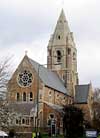For this church:    |
| ||||||||||||||||||||||||||||||||||||||||||||||||||||||||||||||||||||||||||||||||||||||||||||||||||||||||||||||||||||||||||||||||||||||||||||||||||||||||||||||||||||||||||||||||||||||||||||||||||||||||||||||||||||||||||||||||||||||||||||||||||||||||||||||||
 |
 |
During the 1905 extension of St. Andrew's, the organ was moved from the ground floor to a purpose-built loft. Rebuilding the organ whilst retaining the original Snetzler stops was carried out by Charles Lloyd in 1914 at a cost of £500. In 1920 a new organ case of carved and panelled oak was fitted. The case and also the carved oak chancel stalls, which had been installed the previous year, were the gift of Richard Wilkinson to commemorate fifty years of married life. During the 50th anniversary celebrations of 1921 the organ was cleaned and tuned by Charles Lloyd. It was re-built again in 1934 by Hill, Norman & Beard. In 1970 the Snetzler organ was stated to require £2,000-3,000 of restoration work; however, it is uncertain whether these works, envisaged as part of the centenary celebrations, were carried out.
The National Pipe Organ Register provides the following information which dates from 1932 survey:
Nottinghamshire Nottingham, St. Andrew, Mansfield Road [A00040]
Anglican Parish Church
Grid ref: SK5641
Survey date: 1932
Organ playable
Builders
1876 Bishop
see N13543
1898 Bishop
Additions
1914 Lloyd & Co
Renovation
1926 Roger Yates
Tuba added
Cases
Position N Transept gallery
Department and Stop list
| Pedal | Key action EP Stop action El Compass-low C Compass-high f1 Keys 30 | |||
| 1 | Subbass | 32 | l open to G, + acoustic quint | |
| 2 | Open Diapason | 16 | l Ext. 1 | |
| 3 | Violone | 16 | c No. 16 | |
| 4 | Bourdon | 16 | b | |
| 5 | Octave | 8 | b No. 2 | |
| 6 | 'Cello | 8 | c No. 3 | |
| 7 | Bass Flute | 8 | b No. 4 | |
| 8 | Trombone | 16 | l Wood/Metal | |
| Choir | Key action EP Stop action El Compass-low C Compass-high c4 Keys 61 Enclosed | |||
| 9 | Gamba | 8 | b Spotted metal | |
| 10 | Lieblich Gedackt | 8 | b | |
| 11 | Dulciana | 8 | b | |
| 12 | Harmonic Flute | 4 | b from tenor C | |
| 13 | Orchestral Oboe | 8 | l | |
| 14 | Clarinet | 8 | b | |
| 15 | Tuba Magna | 8 | y Unenclosed No.45 | |
| Great | Key action EP Stop action El Compass-low C Compass-high c4 Keys 61 | |||
| 16 | Contra Gamba | 16 | ||
| 17 | Bourdon | 16 | s Wood/metal | |
| 18 | Open Diapason I | 8 | l | |
| 19 | Open Diapason II | 8 | c | |
| 20 | Open Diapason III | 8 | s | |
| 21 | Hohl Flote | 8 | l | |
| 22 | Rohr Gedackt | 8 | ||
| 23 | Principal | 4 | l | |
| 24 | Rohr Flote | 4 | ||
| 25 | Twelfth | 2 2/3 | ||
| 26 | Fifteenth | 2 | ||
| 27 | Sesquialtera | III | s | |
| 28 | Tromba | 8 | ||
| Swell | Key action EP Stop action El Compass-low C Compass-high c4 Keys 61 Enclosed | |||
| 29 | Bourdon | 16 | b | |
| 30 | Open Diapason | 8 | c | |
| 31 | Viola | 8 | c Stopped metal | |
| 32 | Stopped Diapason | 8 | s Wood/metal | |
| 33 | Salicional | 8 | c | |
| 34 | Voix Celeste | 8 | c | |
| 35 | Principal | 4 | s | |
| 36 | Suabe Flote | 4 | b open metal | |
| 37 | Mixture | III | c 17-19-22 | |
| 38 | Cornopean | 8 | c | |
| 39 | Oboe | 8 | c | |
| Solo | Key action EP Stop action El Compass-low C Compass-high c4 Keys 61 Enclosed | |||
| 40 | Viol d'Orchestre | 8 | l | |
| 41 | Viole Celeste | 8 | l | |
| 42 | Concert Flute | 8 | l Harmonic trebles | |
| 43 | Tuba | 8 | l Harmonic trebles | |
| 44 | Waldhorn | 8 | y | |
| 45 | Tuba Magna | 8 | y Unenclosed, Harmonic trebles | |
Console
Pedalboard Wesley-Willis
Couplers
Swell to Pedal
Swell to Great
Swell to Choir
Swell octave
Swell suboctave
Swell unison off
Choir to Great
Choir to Pedal
Choir octave
Choir suboctave
Choir unison off
Great to Pedal
Great octave
Great suboctave
Great unison off
Solo to Pedal
Solo to Great
Solo Sub Octave
Solo Octave
Details
Blowing Electric
Accessories
Gt/Ped pistons coupled (rocking tablet) Tremulants to Swell (pedal), Choir (rocking tab), Solo 3 thumb pistons to Choir 5 thumb pistons to Great 5 thumb pistons to Swell (one of each adjustable) 3 thumb pistons to Pedal 3 toe pistons to Great 3 toe pistons to Swell Reversible piston: Gt to Ped
Further information
The electric blower was added in 1928 Wind Pressures - Solo 7" Tuba Magna 15" Pipe derivation: s Snetzler c Conacher l Lloyd y Yates b Bishop






